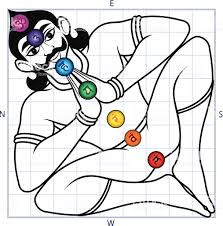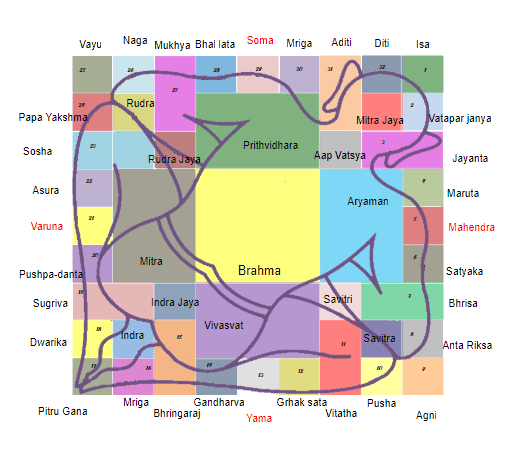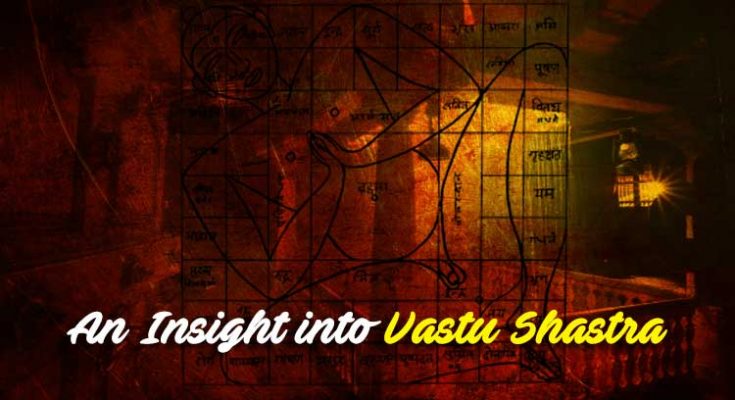Vaastu Shastra
In reality, what is Vaastu Shastra or Vaastu Vidya?
The word was born from the Sanskrit word “Vas”. The meaning is to live or to stay. Vaastu Vidya is explained in a part of the Atharva Veda(the fourth book of the Vedas) called Sthapathya Veda which deals with architecture.
This science of architecture assures the equilibrium in nature. The earth’s atmosphere comprises more than 70% of Nitrogen, 20% of Oxygen and other alternate gases. This ratio of nature is seen in the human body too. Keeping that perspective in mind, synchronization between the earth who gives us a space to live in and the people who live on it is seen.

Therefore, for every construction that is done on earth, this Universal Theory of Balance should be taken into consideration. This is applicable to animals and birds as well. This proportionality becomes inevitable. Vaastu is the home for mortals as well as immortal beings. In this, birds, animals, trees and humans come in as mortals while gods, lesser gods, souls come under immortals. That is the reason why Vaastu Shastra insists that an action as simple as planting a tree has to be done in the place intended only for it. Vaastu Shastra is the art of adjusting the house, household appliances and rooms by the divine laws of Vaastu.
Best Jyothish Software for Prasna, Muhurtha, and Panchanga – Get Quote
Nature is made up of the Panchabhoothas or otherwise known as the five elements namely Earth, Water, Fire, Air, and Sky. The human body is also oriented with the five elements of nature. Vaastu Shastra helps in comprehending these elements in the construction of the house.
Origin of Vaastu Purusha
 Any construction built is through the imagination of the Vaastu Purusha. The Puranas say that the Vaastu Purusha was an experiment of Lord Brahma in making a cosmos being. As this cosmos being grown larger with time, so did its hunger. It started devouring everything in its way. Very soon it grew so big that its shadow caused a permanent eclipse on earth. The Gods panicked. When approached for help, Lord Brahma threw the man onto the earth. To overpower him, the help of the Gods of the Eight Directions was called for. They pinned him against the ground with his head in the North-East and legs in the South-West. Lord Brahma jumped onto his centre and held him down. When asked why he was being treated this way for no reason of his, Lord Brahma replied saying that he agreed with the man, but he being a threat will have to remain in that position. When asked about the benefit in that, Lord Brahma satisfied him by saying that he would be an immortal and all mortals who build any construction will have to worship him. To those who do not worship him or keep him happy, he would be free to tease, devour, and trouble them. The man was blessed to be present in all of the lands and will henceforth be known as Vaastu Purusha. Vaastu Purusha agrees and becomes an inseparable part of the earth.
Any construction built is through the imagination of the Vaastu Purusha. The Puranas say that the Vaastu Purusha was an experiment of Lord Brahma in making a cosmos being. As this cosmos being grown larger with time, so did its hunger. It started devouring everything in its way. Very soon it grew so big that its shadow caused a permanent eclipse on earth. The Gods panicked. When approached for help, Lord Brahma threw the man onto the earth. To overpower him, the help of the Gods of the Eight Directions was called for. They pinned him against the ground with his head in the North-East and legs in the South-West. Lord Brahma jumped onto his centre and held him down. When asked why he was being treated this way for no reason of his, Lord Brahma replied saying that he agreed with the man, but he being a threat will have to remain in that position. When asked about the benefit in that, Lord Brahma satisfied him by saying that he would be an immortal and all mortals who build any construction will have to worship him. To those who do not worship him or keep him happy, he would be free to tease, devour, and trouble them. The man was blessed to be present in all of the lands and will henceforth be known as Vaastu Purusha. Vaastu Purusha agrees and becomes an inseparable part of the earth.
Vaastu Purusha Mandala
The section of ground where Vaastu Purusha was pinned down with the help of 45 Gods including Brahma on and around his body is called Vastu Purusha Mandala. It is to satisfy these gods that a Vaastu Bali and a Vaastu Puja are performed before building a house. However big or small the Vaastu is, there will always be a Vaastu Mandala and a Vaastu Purushan. Vaastu Purushan is the lord of the Vaastu. In a way, it is the Earth that is the Vaastu Purushan which is why Vaastu Puja becomes Bhumi Puja. Whatever advantages and disadvantages that Earth has, it is the same everywhere irrespective of its size.
Vaastu Purusha Mantra
नमस्ते वास्तु पुरुषाय भूशय्या भिरत प्रभो |
मद्गृहं धन धान्यादि समृद्धं कुरु सर्वदा ||
Namaste Vaastu Purushaay Bhooshayyaa Bhirat Prabho |
Madgriham Dhan Dhaanyaadi Samriddham Kuru Sarvada ||
The influence of the Sun is also seen when it comes to building a structure. Sun being the conscious center of the solar system all planets including the earth that we live on are controlled by the Sun. Therefore, a house must be built on land with adequate sunlight. Simply put, the house should be constructed such that the sun at dawn and the stars at dusk should be seen and the shadow of the sun does not fall on the land. The most important of the stars are the Saptarishis which are located in the north. Therefore selecting a low-lying land to the north and east side would be most appropriate for a home. Rays of the rising sun will also be got on the low-lying land in the south. The Sun, Sky, Atmosphere, Earth, Seasons and different forms of Lord Aditya influence the home.
Previous: Vastu Tips for Kitchen Layout








